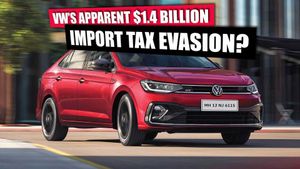Stellantis is undergoing significant changes at the management level following the departure of its Chief Executive Officer Carlos Tavares, which marks the beginning of fresh strategies aimed at revitalizing the company and positioning it for future success. The automaker, which has seen its value plummet by roughly half since March 2024, is determined to make substantial adjustments as it strives to recover from past challenges.
According to Bloomberg, multiple sources have indicated Stellantis is planning to implement more management changes as it seeks to navigate through these troubled waters. The recent shakeup aims to invigorate the leadership structure to align with new goals and boost overall company morale within the ranks.
Jeff Kommor, Senior Vice President of Commercial Sales for Stellantis North America, provided optimism about the company's direction, stating, "Keep an eye on us all year long. You're going to see incremental improvements, you're going to see momentum, you're going to see sales gains. The dealers got our back, we got their back, and I feel like we're starting to gain their trust and optimism back." He emphasized the need for synergy between the company and its dealer network, hinting at efforts to mend relationships damaged over the past years.
The automaker’s ambitions stretch well beyond mere management changes. Stellantis is gearing up for significant investments and initiatives slated for 2024 and 2025. Plans include the exploration of powertrain opportunities and re-entry to vehicle segments previously abandoned. Specifically, the company is poised to invest over $5 billion to bolster its U.S. manufacturing base, which includes notable plans for the assembly plant located in Belvidere, Illinois. This facility will produce new midsize pickups, enhancing the product lineup and aiming to capture market interest.
Further investments hinge upon strengthening its production capabilities at the Detroit plant, which will manufacture new Dodge models, alongside significant developments at its Toledo site responsible for Jeep trucks. Such initiatives are expected to give Stellantis the edge it has been seeking to become more competitive across its various brands, which include household names like Ram, Jeep, and Alfa Romeo.
Driven by necessity, Stellantis has recently taken decisive steps to cut its U.S. inventory by more than 100,000 vehicles. This strategic move serves as relief for dealerships grappling with bloated stock levels, which necessitated heavy discounts and profit-eroding incentives. By trimming excess inventories, Stellantis hopes to stabilize supply chains and reinforce its dealerships with healthier sales models.
Nonetheless, Stellantis is not without its hurdles. A significant concern looms with the potential for tariffs from the U.S. administration. Former President Donald Trump has hinted at the imposition of additional tariffs, which could affect imports from Canada and Mexico, where about 40% of Stellantis’ U.S.-sold vehicles are manufactured. Such tariffs could dramatically impact the company's profitability and market stability, as outlined by Moody’s and S&P Global reports.
Analysts warn of dire predictions for American and European automakers should tariffs be enacted, estimating potential losses topping 17% of annual core profits. Stellantis finds itself particularly vulnerable due to its operational dependencies on cross-border supply chains. This uncertainty adds complexity to the company’s efforts to regain stability and investor confidence.
While the uncertainty surrounding tariffs raises flags for investors, there exists considerable potential for upside should Stellantis successfully implement its outlined strategies. Currently, the automaker is trading at what some analysts describe as rock-bottom price-to-earnings ratios and shows signs of excessive undervaluation when compared to its competitors. Notably, Stellantis has adjusted its dividend yield to approximately 12.4%. This change, driven by the decision to distribute 25% to 30% of net profits as dividends, reflects the company's aim to maintain investor interest even amid challenges.
Despite these promising signals, both analysts and investors agree it’s too early to jump on the Stellantis comeback bandwagon just yet. With extensive turnaround challenges continuing on the horizon and uncertainty persisting over tariffs and trade policies, many experts advise caution before making significant financial commitments.
Indeed, Stellantis embodies the essence of a comeback story. All eyes will now be on how well the automaker navigates its shifting operational dynamics, rebuilds dealer relationships, strengthens its manufacturing base, and mitigates external dangers such as tariffs. If executed correctly, the company's turnaround could transform perceptions and restore investor confidence.



